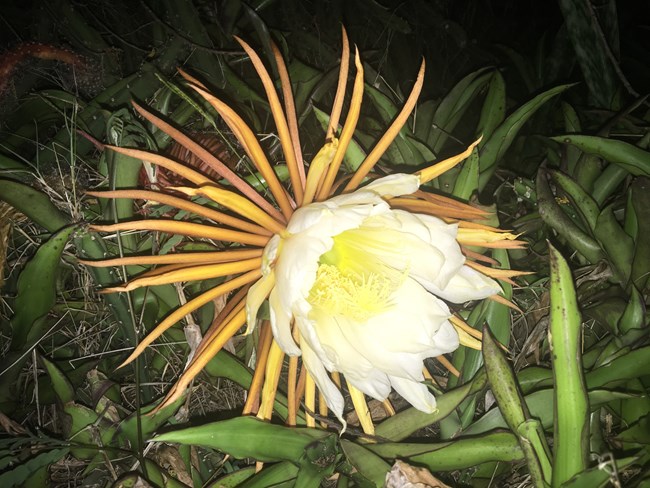
Living in these forest communities are some 748 species of plants and trees. Of those, 642 are native to St. John. Native plants and trees are those that reached here without the help of people. Their seeds were carried by wind, waves or maybe birds to the island. The dominant type of forest on St. John is dry tropical forest. It can be found on the eastern and southeastern portions of the island as well as low-lying coastal areas. It represents 50.51% of the forest community. Common trees of the dry forest are: turpentine (Bursera simaruba), water mampoo (Pisonia subcordata), wild frangipani (Plumeria alba), gris gris (Bucida buceras) and genip (Melicoccus bijugatus). Plants of the dry tropical forest include the night-blooming cereus cactus (Hylocereus trigonatus) and the wild pineapple (Bromelia penguin). 
NPS photo/ A. Smith The third most common forest type is moist tropical forest. It represents 10.43% of the forests of St. John. Moist forests receive more rainfall than any other forest type. Often there are guts located within the moist forest which flow with fresh water after a heavy rain. Moist forests contain the tallest trees on the island, some reaching almost 100 feet. Trees found in the moist forest include the kapok (Ceiba pentandra), sandbox (Hura crepitans), locust (Hymenaea courbaril), hog plum (Spondias mombin), teyer palm (Coccothrinax alta), mango (Mangifera indica) and bay rum (Pimenta racemosa).
Even though it only accounts for 1.8% of the forest on St. John, wetlands are an extremely important area. They are so important, wetlands are legally protected from disturbance and harm under Virgin Islands law. Wetlands are found near the coast in areas that periodically flood with rain or salt water. Three species of mangroves can be found in our wetlands. They are red mangrove (Rhizophora mangle), black mangrove (Avicennia germinas) and white mangrove (Laguncularia racemosa). Currently 31 species of St. John’s plants and trees are listed as threatened or endangered by the local or federal government. Hopefully with the park’s protection, the forests will continue to survive and some of the species in trouble will recover. For a complete list of endangered plants and animals of the Virgin Islands, log on to the web page of the Virgin Islands Division of Fish and Wildlife at : www.vifishandwildlife.com. |
Last updated: September 3, 2017
